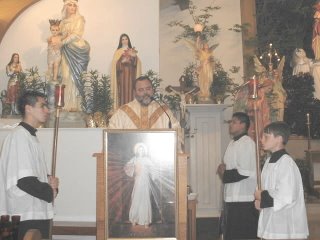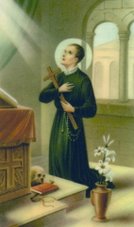
For some time I have read with interest a lot of literature comparing the liturgy of the old, Tridentine Rite, with that of the new Rite which is said throughout the Western Catholic Church. It didn't take much convincing me to see the important theological considerations, of which the Ottaviani Intervention has to be the most prophetic (written in 1969).
However, since I have been attending the Old Rite of Mass there is something else which has grabbed me: the form or aesthetics of the Mass. Fr. Tim Finigan has just advertised a book which seems to draw attention to this aspect of the mass, and I personally think it is this distinction which divides opinion.
Much has been said of the change towards a 'horizontal' understanding of the Mass; where emphasis is placed on the community gathered rather than a worship directed towards God. This is clearly evident in the way the priest, in most churches, now celebrates the Holy Sacrifice versus populum, facing the people. Furthermore, many modern churches are now designed so that the community is arranged in a circle around the altar in an attempt to make the celebration more inclusive and community centred. These aesthetics are clearly recognisable, but what of the churches that celebrate the new mass in a more traditional manner?
 From the picture above (in an old low mass setting), and the picture below (a high mass in the new Rite), I hope to illustrate the one clear distinction between the old mass and a highly reverent modern mass: The way the 'Liturgy of the Word' is presented.
From the picture above (in an old low mass setting), and the picture below (a high mass in the new Rite), I hope to illustrate the one clear distinction between the old mass and a highly reverent modern mass: The way the 'Liturgy of the Word' is presented.
 From the picture above (in an old low mass setting), and the picture below (a high mass in the new Rite), I hope to illustrate the one clear distinction between the old mass and a highly reverent modern mass: The way the 'Liturgy of the Word' is presented.
From the picture above (in an old low mass setting), and the picture below (a high mass in the new Rite), I hope to illustrate the one clear distinction between the old mass and a highly reverent modern mass: The way the 'Liturgy of the Word' is presented. Picture courtesy of Semper Fi Catholic
Picture courtesy of Semper Fi CatholicThis is something which has always struck me, but doesn't seem to get commented upon. The fact that the two parts of the mass now have these different names; The Liturgy of the Word, and The Liturgy of the Eucharist, displays a rupture which is evident mainly in the manner in which these two are performed: One from the pulpit, and the other from the altar. This serves to separate the mass into two parallel ideas: That God's word is present in the Scriptures and in the Eucharist independently from one another. Pope John Paul II put it like this, in his apostolic letter Mane Nobiscum Domine:
In the Old Mass, I would argue that this unity is preserved better because the Epistle and Gospel are both said from the altar. I realise the situation is slightly different in a High Mass (which I haven't yet had the fortune of attending), but to see the altar so empty and neglected throughout the first half of a new mass is quite disconcerting now that I have seen the other side. Why is it that, in the new mass, the readings have to be conducted from a pulpit? Even in churches where they preserve the ad orientem direction of worship, we have a change of emphasis during the liturgy of the word whereby the thrust of the worship is towards the congregation, and no longer orientated towards God.

Simply put, the Old Mass, with its integration of the two halves of the liturgy, fills me with joy and satisfaction. The sight of the Missal being transferred from the Epistle side to the Gospel side, for me, is of profound beauty and symmetry in the Eucharistic Sacrifice. Moreover, the fact that it is purely the priest who offers to God these sacred readings from Scripture, put me in no doubt that the Mass is orientated solely towards God, in the person of Christ. A rupture in the Mass, such as we now have, results in such displays as "Liturgy of the Word followed by Holy Communion" which doesn't even require a priest to be present. It is little wonder that vocations have plummeted when faced with the way the priesthood is being presented in the new Mass.
The Eucharist is light above all because at every Mass the liturgy of the Word of God precedes the liturgy of the Eucharist in the unity of the two "tables", the table of the Word and the table of the Bread.Now, John Paul II was of course light years ahead of me in both holiness and knowledge, so I'm not going to try and critique what he's saying. But it is evident that the two parts of the mass are set aside each other, supposedly having equal dignity as "two tables".
In the Old Mass, I would argue that this unity is preserved better because the Epistle and Gospel are both said from the altar. I realise the situation is slightly different in a High Mass (which I haven't yet had the fortune of attending), but to see the altar so empty and neglected throughout the first half of a new mass is quite disconcerting now that I have seen the other side. Why is it that, in the new mass, the readings have to be conducted from a pulpit? Even in churches where they preserve the ad orientem direction of worship, we have a change of emphasis during the liturgy of the word whereby the thrust of the worship is towards the congregation, and no longer orientated towards God.

Simply put, the Old Mass, with its integration of the two halves of the liturgy, fills me with joy and satisfaction. The sight of the Missal being transferred from the Epistle side to the Gospel side, for me, is of profound beauty and symmetry in the Eucharistic Sacrifice. Moreover, the fact that it is purely the priest who offers to God these sacred readings from Scripture, put me in no doubt that the Mass is orientated solely towards God, in the person of Christ. A rupture in the Mass, such as we now have, results in such displays as "Liturgy of the Word followed by Holy Communion" which doesn't even require a priest to be present. It is little wonder that vocations have plummeted when faced with the way the priesthood is being presented in the new Mass.

















That is a very perceptive and intelligent post. I agree with you that the separation of the "Liturgy of the Word" and the "Liturgy of the Eucharist" tends to separate the Scriptures (the Word of God) from the Eucharist (the real presence of the Word of God).
ReplyDeleteAlthough perhaps the neglect of the altar and focus on the chair and ambo during the Liturgy of the Word might create an impression of division, the idea of the "Liturgy of the Word" and the "Liturgy of the Eucharist" surely derive from the "Mass of the Catechumens" and the "Mass of the Faithful", the first having reading from Scripture and catechesis as its central point, and the second the Eucharistic sacrifice? The reading of the Epistle and Gospel at a high Mass are done completely differently (i.e. not from the altar - there is even, for the Gospel, a significant procession with lights, subdeacon, deacon with evangeliarium, and so forth to a place "well away from the altar") anyway. And since the solemn Mass is the "normal" form of the older rite, does it really make such a significant difference?
ReplyDeleteWhile I do take the point, the Mass has, strictly speaking always had these two aspects, and the Low Mass manner of reading the lessons from the altar is rather a reduction due to circumstances than the ideal way of celebrating Mass, isn't it?!
I had expected a comment like that, Chris, which is why I mentioned that a high mass is very different. However, I do think that the altar maintains the focus even then. Really I only wanted to comment on my experience of high/sung masses. I daresay the Sung Mass was more usual than the High Mass, which requires a lot more clerical support.
ReplyDeleteThe mass did used to have a divide (catechumens/faithful) which was most significant because only baptised Catholics could remain for the actual sacrifice of the mass. However, I think the rupture is much more apparent now - both in the terms used for the two parts and in the way they are presented to the faithful. When I attend an old mass, it feels much more complete and unified - all an act of worship orientated towards God. There also arises the argument that scriptural elements should remain in the first part of the mass only, which has been used as a justification for eliminating the last Gospel for instance. The fact is the whole Mass, with all its prayers and invocations, are steeped in scripture, and to make a specific divide is both unnecessary and, I would argue, counterproductive.
Whoever said that the Mass is "unscriptural", should just look at the old rite and see how much scripture is used!!!
ReplyDeleteNice to see Fr. Paul, our pastor, on your blog!
ReplyDeleteGod bless you